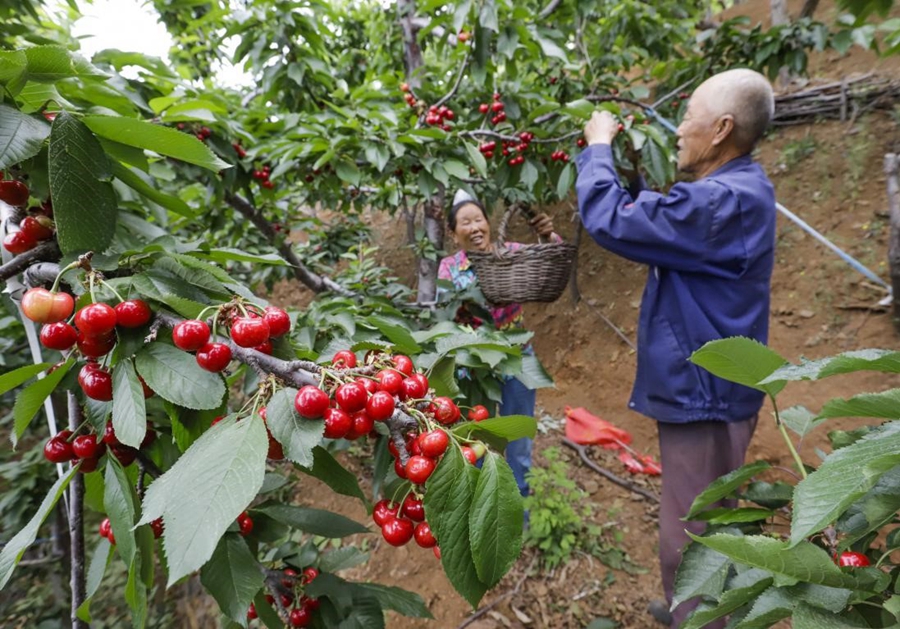Improving roads and network help vitalize village in central China’s Hubei province
 |
| Farmers pick cherries at a hillside orchard in Qiukeyu village, Houjiazhai township, Zunhua city, north China’s Hebei province, May 26, 2021. (People’s Daily Online/Liu Mancang) |
Thanks to projects for improving roads and network coverage, Lianziyan village in central China’s Hubei province has increased the sales of local fruits and achieved vitalization.
Located in the depths of mountains, Lianziyan in Quyuan township, Zigui county, Yichang city of Hubei was connected with the outside world with only one waterway. Due to the poor transportation, local farmers couldn’t possibly earn a living by selling navel oranges, chestnuts and other regional specialties, and many left their hometown to work in cities.
“Villagers really hoped to see new roads in Lianziyan, which they believed would lead them to a better life,” said Du Bingxiang, a resident in Lianziyan.
Under China’s strategy of targeted poverty alleviation, a cement road that links Lianziyan to the country’s National Highway 318 was built. Besides, buses that run between Lianziyan and Zigui county and urban areas of Yichang city were also put into operation.
Just like capillaries that run through the human body, hardened roads stretch out to fields and households in Lianziyan, making it easier for villagers to transport local fruits to other regions of China.
However, as fruit industry prospers, Lianziyan encountered new difficulties. The current 3.5-meter-wide roads could no longer satisfy locals’ needs as the planting area and sales of fruits grew, as pointed out by Yang Tao, secretary of the branch of the Communist Party of China in Lianziyan.
Yang explained that the 3.5-meter-wide roads, which are wide enough for the passage of tricycles, main vehicles for the transportation of local fruits in the past, can’t support large trucks which are needed nowadays.
Driven by a series of policies on fueling rural vitalization in China, authorities in Zigui county recently implemented a road expansion project in Lianziyan village, which is aimed at solving the problem troubling the village.
The project, which intends to widen the 4-kilometer mountain roads in Lianziyan, will be completed next year and is expected to bring new opportunities to local people, Du noted.
“Peaches that mature in June, plums harvested in July, upcoming seedless pomegranates and navel oranges, and other local fruits have now been guaranteed with decent sales channels,” Du said while picking and packaging fruits at his orchard.
Lianziyan is an epitome of China’s rural vitalization campaign, in which infrastructure modernization has played an important part.
So far, all administrative villages with the proper conditions have been covered by hardened roads, passenger vehicles, and mail service network. 83 percent of the villages in China have gained access to tap water and been guaranteed with safe drinking water, and over 98 percent of the villages in the country have been equipped with fiber-optics Internet and 4G networks.
China will continuously focus its efforts on the construction of public infrastructure in rural areas, and strive to extend infrastructure into households in villages, according to the country’s No.1 Central Document for 2021.
Besides improving roads, rural areas are also seeing upgrading networks. In October 2020, Zigui county was included as one of the first batch of areas for China’s pilot project of digital villages. Under the project, Lianziyan has built two 5G base stations and two 4G base stations, and set up 252 fiber-optics broadband ports this year. The village has been fully covered by wired and wireless networks.
“Each household has a doorplate with a QR code on it, which leads to the online stores of villagers. Owners of agritainment restaurants even allow customers to order by scanning the QR code,” Yang said.
Hardened roads and network cables have given fresh impetus to the development of Lianziyan village, enabling special agricultural products of the mountainous village to be sold across China via online platforms.
This year, Du bought the use right of 6.67 hectares of land for growing tea. “Earlier a company came to the village for investigation as it plans to build a tea processing factory here. If the factory is built, villagers like me can sell tea without leaving our homes,” Du said.
According to Kong Xiangzhi, a professor at the School of Agricultural Economics and Rural Development, Renmin University of China, to improve rural infrastructure requires making traditional infrastructure including water, electricity, road, gas, housing and communications available to more rural households while advancing new type infrastructure construction to support the modernization of agriculture and rural areas.
To deal with the sluggish sales and large circulation loss in modern agriculture, China’s Ministry of Agriculture and Rural Affairs launched a project in 2020, under which the central government provided five billion yuan ($772 million) to support 16 provinces, autonomous regions and municipalities in building cold chain facilities for storage and preservation in a bid to reduce the postharvest loss of agricultural products.
 |
Photos
Related Stories
- Scenery of Hemu Village of Kanas in Xinjiang
- People visit village in Siguenza city, Spain
- Huawu Village takes on new look with various industries greeting booming dev't
- Old village in Zhejiang province revitalized through green, eco-friendly development
- Village-level cultural centers spring up in China's Anhui
Copyright © 2021 People's Daily Online. All Rights Reserved.










